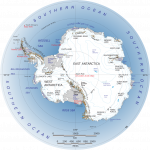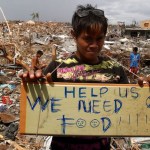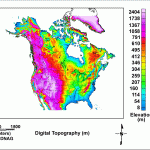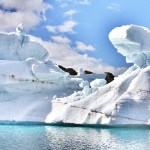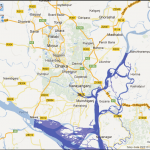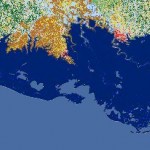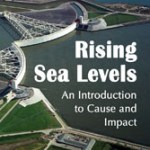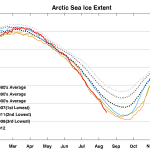sea level rise
There is an old theory in psychology that characterizes humans as a bowl of Jell-O (Jelly for some of you). Life pokes at the Jell-O, the Jell-O jiggles. Eventually the jiggles begin to change the Jell-O, so certain kinds of pokes result in certain kinds of responses. The Jell-O gurgles, babbles, notices things, learns, develops, and eventually becomes self aware.
That is a great oversimplification of a theory that was, in turn, a great oversimplification of human development, yet it does seem to apply in many ways to human behavior. When it comes to climate change, people seem more…
Independent videographer Peter Sinclair's 'This is Not Cool' video explores recent headline-grabbing research on Antarctic glacial melting, the first video produced under the name Yale Climate Connections, formerly The Yale Forum on Climate Change & The Media.
We saw it coming, the denialists denied, they were wrong, this is all pretty bad.
April 27th, I'll be giving a talk hosted by Minnesota Atheists at the Maplewood Library, 3025 Southlawn Dr, Maplewood, Minnesota. Details are here.
Details:
You may attend any part of the meeting you wish, here's the schedule:
1:00-1:15 p.m. – Social Time
1:15-1:45 p.m. – Business Meeting
1:45-2:00 p.m. – Break
2:00-3:30 p.m. – Talk by Greg Laden
4:00-whenever – Dinner at Pizza Ranch (1845 County Road D East, Maplewood MN)
This will be a talk about climate change focusing on current and challenging research questions that everyone needs to know about, as well as the relationship between…
First, let me note that if you are not a regular reader of Peter Sinclair's "Climate Denial Crock of the Week" you should be.
Peter's latest video is "Abrupt Climate Change, and the Expected Unexpected"
Senior Scientists discuss the potential for sudden disruptions of human and natural systems as a consequence of climate change.
I've noted this before. Here is Peter Sinclair's video on the topic:
The most sobering evidence of the planet's response to greenhouse gases comes from the fossil record. New evidence scientists are collecting suggests that ice sheets may be more vulnerable than previously believed, which has huge implications for sea level rise.
Update on Haiyan/Yolanda Death Toll
The final figures are not likely in but the numbers have stabilized and we can now probably put a number to the human toll of this storm that will not change dramatically in the future, at least in terms of orders of magnitude. The current “official” death toll in the Philippines from Typhoon Yolanda/Haiyan is 6,009 with 1,779 missing and 27,022 injured, with the largest concentration of casualties in Eastern Visayas. This comes from a December 13th report of the National Disaster Risk Reduction and Management Council, which you can (probably) download here…
An interview with Michael Mann on metastable shifts in climate:
Published on Sep 24, 2013
In recognition of climate week, Thom talks with renowned climate scientist Dr. Michael Mann about the dangers of global warming. Dr. Mann in concerned we may be running out of time to rein in global temperatures.
Most of the current models of glacial ice melting (and contribution to sea level rise) focus on ice melting and less than they need to on the process of glaciers falling apart in larger chunks such as ice bergs. Also, current understanding of glacial ice melting due to global warming indicates that the Western Antarctic Ice Sheet (WAIS) is more vulnerable to melting over coming decades or centuries than is the Eastern Antarctic Ice Sheet (EAIS). New research from two different teams seems to provide a major corrective to these assumptions.
First, about how glaciers turn into ocean water.…
The National Academies Press of the United States has recently released a report that will be of interest to those of you concerned with climate change (which better be every one of you dammit!). The report talks about increasing floods due to weather whiplash and sea level rise due to glacial melting (and subsidence), mainly in relation to the levees program and insurance, but also more generally. Here's a small excerpt to give you a flavor:
Community flood risk scenarios will continue to evolve as change occurs. Climate change will have a variety of regional impacts, and the geographic…
NOTE: I've rewritten this post and redone the graphic. The original map on which I based the reconstruction, provided by the USGS, is distinctly different than the one the USGS provides today. The difference is, in fact, rather dramatic. In comparing the older and newer versions of the maps, I have decided to assume the later, more recent, version is more correct. I admit to being a little annoyed at the USGS providing a truly bogus map on their web site, but that is water under the bridge, as it were. So, the following post is edited a bit and a new graphic is provided. Thanks to…
A paper came out in today’s Nature about glacial melting and its contribution to sea level rise. This paper does not present new research, but rather summarizes and evaluates the last several years of research on modeling and measuring contiental glaciers and their dynamics.
From the Abstract:
Since the 2007 Intergovernmental Panel on Climate Change Fourth Assessment Report, new observations of ice-sheet mass balance and improved computer simulations of ice-sheet response to continuing climate change have been published. Whereas Greenland is losing ice mass at an increasing pace, current…
The planet has passed a disturbing landmark, a marker on a continuing highway to climate disruption. On May 9th, the NOAA and the Mauna Loa observatory reported that atmospheric CO2 levels touched 400 parts per million. Before humans started burning fossil fuels, they were around 280 parts per million.
Mauna Loa measurements of carbon dioxide. From http://keelingcurve.ucsd.edu/
The last time atmospheric CO2 was at 400 parts per million was during the ancient Pliocene Era, three to five million years ago, and humans didn’t exist.
Global average temperatures were 3 to 4 degrees C…
You've all heard about the horrible tragedy in Bangladesh, still unfolding. Not to distract from that event, or diminish its importance, I thought it would be interesting to have a look at that low lying country in relation to long term sea level rise caused by climate change. I am making no claim here about the maximum rate of sea level rise or about the timing of sea level rise. But the truth is, there have been times in the past when there was virtually no year round ice (glaciers) anywhere on this planet, and sea levels were much higher than they are now. During a time period not too…
Sometime, about one year from now, the front pages of whatever decent newspapers are left will carry a headline like the one above, announcing that for the first time in human existence (or in nearly a million years, or 3 million years, or 15 million years), the global atmospheric concentration of carbon dioxide – the principal gas causing climate change – will have passed 400 parts per million.
That’s a significant and shocking figure. Unfortunately, it is only a temporary marker on the way to even higher and higher levels. Here (Figure 1 below) are the most recent (March 2013) data from the…
One of the most important and threatening risks of climate change is sea-level rise (SLR). The mechanisms are well understood, and the direction of changes in sea-level is highly certain – it is rising and the rate of rise will accelerate. There remain plenty of uncertainties (i.e., a range of possible outcomes) about the timing and rate of rise that have to do with how fast we continue to put greenhouse gases in the atmosphere, the responses of (especially) ice sheets in Greenland and Antarctica, and the sensitivity of the climate.
Even little changes can have big consequences. As we saw…
According to some estimates, if sea levels rose one meter, Boston would lose 3% of it’s land surface, Washington DC a mere 1%. Tampa and Miami would lose 18% and 15% respectively. New Orleans would lose 91%.
A six meter rise would result in much larger losses. Norfolk, Virginia and Miami Florida would be essentially gone.
These estimates use the assumption that the sea level rises in those areas vertically, and the corresponding topographical level in the coastal city becomes the shoreline. They don’t account for the fact that the ocean does not work that way. (see Sea Level Rise…Extreme…
Rising Sea Levels: An Introduction to Cause and Impact is a new book by Hunt Janin and Scott Mandia. Janin is a writer of non fiction and scholarly books, and Mandia is a professor of physics and a science communicator who specializes in climate-related issues.
To me, sea level is one of the most interesting and important of climate related issues. Interesting because I've done archaeology at the edge of the sea, sometimes beneath it, sometimes racing ahead of it, and often, looking at changes in human settlement caused by its rise since the Last Glacial Maximum. Important because one of…
We are becoming aware of two very important changes in the Arctic that you need to know about. These are separate thing but related, and both are almost certainly the outcome of anthropogenic global warming (AGW). They are:
The sea ice that covers much of the Arctic Sea during the winter is normally reduced during the northern summer, but this year, the reduction has been dramatic. There is less sea ice in the Arctic Circle than recorded in recent history.
The massive continental glacier on Greenland, the largest glacial mass in the Northern Hemisphere, has undergone more melting this…
I've never been completely comfortable using the fate of small island states -- places like Tuvalu and Kiribati and the Seycelles that might be the first to go under as sea levels rise -- as poster kids for the consequences of climate change. For one thing, as difficult as it would be for their populations to abandon their homes, there's just not that many people involved, and so there was never any real chance that their pleas would have much of an effect on industrialized countries. The reality is people react to threats to their own quality of life, not those facing a tiny group on the…
